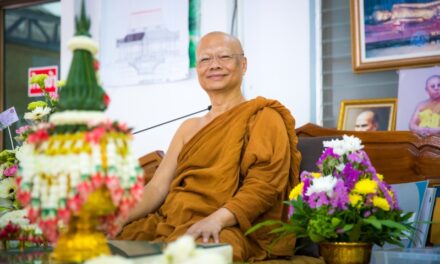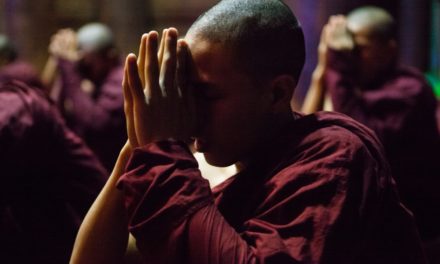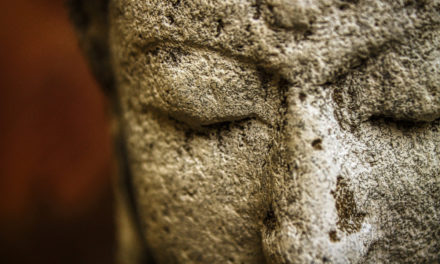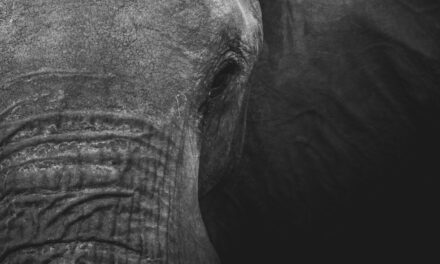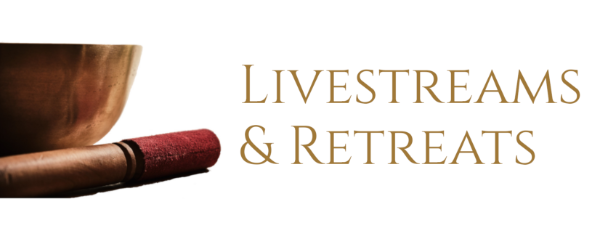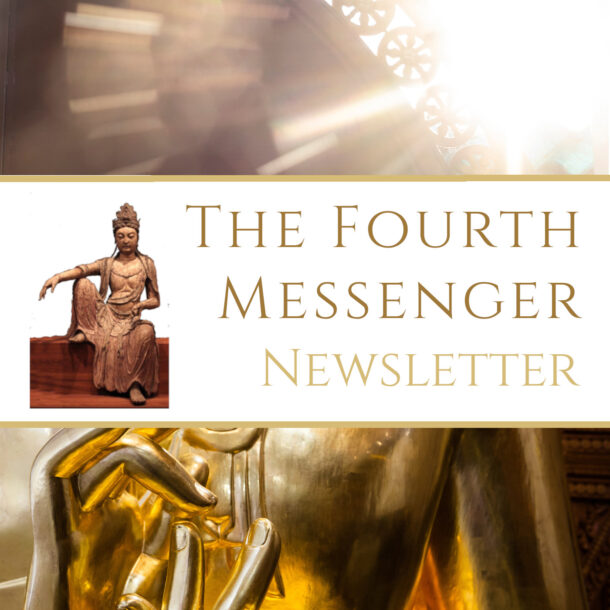A Day in the Buddha’s Life
Bhante Dhammika | Aug. 22, 2022
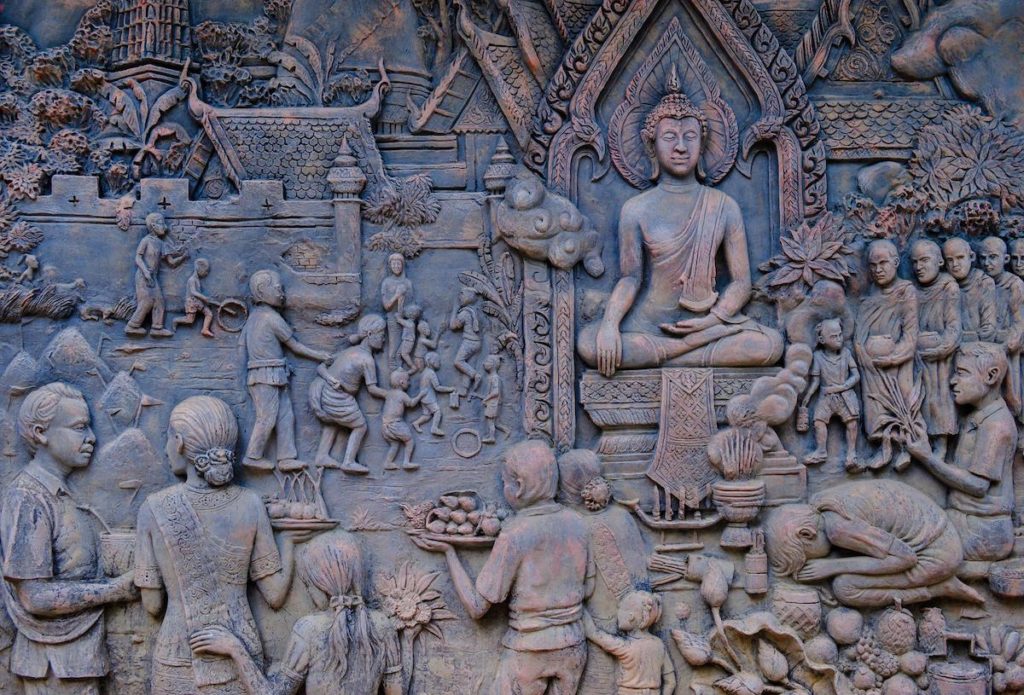 Extract from Bhante Dhammika’s book Footprints in the Dust: The Life of the Buddha from the Earliest Sources, a full copy of which may be found here.
Extract from Bhante Dhammika’s book Footprints in the Dust: The Life of the Buddha from the Earliest Sources, a full copy of which may be found here.
The Tipitaka provides enough information to get some idea of what a normal day in the Buddha’s life might have been like. Of course, this would have changed at different times of the year. For example, during the rains he was sedentary, and the rest of the year he would travel. And it would have changed over time—for example, when he was young and as he grew older. But any one day would have included activities and encounters such as those enumerated in what follows.
The Buddha described his usual morning routine like this:
“When I am dwelling dependent on a village or town, I dress in the morning, take my robe and bowl and enter that village or town for alms. After eating, I go into a nearby grove, make some grass or leaves into a pile and then sit down, crossing my legs and keeping my back straight, arouse mindfulness in front of me” (A.I,182).
The three things mentioned in this passage are the Buddha’s attire, his food and how he obtained it, and his meditation. Each of them is worth detailed examination. The Buddha’s dress consisted of three separate pieces of cloth: a rectangular piece wrapped around the waist and secured by a belt; a larger rectangular robe draped around his whole body, over the left shoulder and under the right arm; and a double-layered robe for use during the winter. These three garments were made up of pieces of cloth sewn together, thus lessening their value and making it less likely that they would be stolen, and each of them was dyed tawny brown or reddish-yellow. The three together were called ticīvara or kāsāva. When the Buddha needed to lie down he would often fold his double-layered robe into four and lie in it, using it as a kind of thin mattress (D.II,134; M.I,354). During the years when the Buddha experimented with various austerities, and perhaps occasionally during the years after his awakening too, he wore robes made of scraps of cast off cloth and rags picked up in the streets or charnel grounds, which was the norm amongst many ascetics. There is at least one reference to him wearing an old robe made of scraps of hemp cloth. He wore such attire later too, but if given robes made of new cloth, he had no objection to using them. The stricter ascetics thought it inappropriate to wear purpose-made robes rather than those made of rags, but the Buddha pointed out that what really mattered was the quality of one’s mind and not what type of attire one wore (M.I,282; Dhp.142). Where the particular style of robe the Buddha used came from is unknown, but it was probably standard dress for certain samaṇa sects, and the Buddha adopted it simply because it was convenient and adequately covered and protected the body.
Many samaṇas, the Buddha and his monks and nuns included, obtained their food by means of a practice called alms gathering (piṇḍacāra), which was not begging, as is often said, but something less intrusive. Beggars plead or importune for alms, while alms gathering involved standing quietly at the door of a potential donor, bowl in hand, eyes downcast, waiting for something to be offered. Alms bowls could be made of either iron or clay, and were either large, medium or small, each with a capacity of half a āḷhaka, a nālika and a pattha respectively of cooked rice, and about a quarter less of raw rice (Vin.III,243). Unfortunately, what these units of capacity represent cannot be determined.
After waiting for an appropriate time, the monk or nun moved on without a word, whether they had received something or not. As cooking at this time was usually done in the evening, when supper, the main meal of the day, was prepared together with the following day’s meals, the best time to go for alms was early in the morning.
Although alms gathering was the main way the Buddha obtained his food, he would occasionally be invited for a meal at the house of a disciple or an admirer, and this occurred more often as his following and his renown grew. The Tipitaka includes a detailed description of how the Buddha conducted himself during one such invitation. A donor would invite him to a meal the following day, and if he accepted, someone would come at the agreed-upon time, inform him that the meal was ready, and accompany him to the house. While waiting for the meal to be served, during it and afterwards, the Buddha did not fidget or sit in a slovenly manner but maintained a comportment of grace and dignity and did everything purposefully. Before eating he would wash his hands. He ate without rushing, chewing each mouthful fully before swallowing it, and did not take more food until he had finished the previous mouthful. It was said that he experienced the flavour but without being greedy for it. After finishing the meal, he washed his hand and bowl, sat silently for a few minutes and then gave thanks to the people who had provided it for him (M.II,138-9). It can be assumed that the Buddha’s behaviour here was in keeping with how a polite and cultured person would be expected to conduct themselves during a meal if they were a guest in someone’s home.
Depending entirely on the generosity of others for sustenance meant that one might receive just broken rice grains, sour gruel, leftovers or, sometimes, nothing (A.IV,392). There are several references to the Buddha alms gathering and receiving nothing, and one text mentions that he went to one particular village and “came back with his bowl as clean as when he went” (S.I,114). A more serious problem with relying on alms gathering for one’s food was being given what he described as “the unrecognisable scraps of strangers” that were spoiled and becoming ill, or even dying, from food poisoning (S.II,281).
Ascetics also had to be careful not to turn up for alms too often and wear out their welcome. At one time the citizens of Rājagaha complained about the number of monks in the city, probably because they were putting a strain on people’s ability to give (Vin.I,79). The Buddha counselled his monks not to inconvenience their donors in any way. “As a bee takes nectar and goes its way without damaging the colour or the fragrance of the flower, so the sage should go through the village for alms” (Dhp.49). Once, while alms gathering in Sāvatthī, the Buddha paused at the house of a particular man who filled his bowl with rice. The next day he went again, and the same thing happened. Mistakenly thinking this was a sign that the donor was happy to give him a generous meal, the Buddha went on the third day, and the man gave him rice but mumbled under his breath: “This troublesome samaṇa keeps coming again and again” (S.I,174).
As with other monks, the Buddha usually ate humble fare, but when invited to a wealthy family’s home, he might have fine rice with various condiments and curries set before him (M.II,78). At Ugga’s home, for example, he was served a dish flavoured with sal flowers, pork stewed with jujube fruit and fried vegetable stalks, together with the best quality rice, with the dark grains removed – obviously a sumptuous meal (A.III,49). The more traditional samaṇas criticised the Buddha for eating such rich food, but he defended himself by saying: “If a monk of such virtue, such concentration or such wisdom were to eat the finest rice with various condiments and curries that would be no obstacle for him” (M.I,38). Just as controversial was the Buddha’s acknowledgment that at times he would eat as much as a whole bowlful of food or more, although he wouldn’t have done this out of greed, given his repeated admonishments to his monks and nuns to eat in moderation (M.II, 6-8). Perhaps he only did this when he had received no alms food or only a meagre amount the day before or for several days in a row.
The Buddha abstained from eating after midday and made it a rule that his monks and nuns should follow his example. His reason for this was related to health. He said: “I do not eat in the evening, and therefore I am free from illness and affliction and enjoy health, strength and ease” (M.I,473). There may have been other reasons for this rule also. Providing alms for a monk once a day would probably be manageable for most people; showing up twice a day might be burdensome for householders. Furthermore, doing no physical labour, monks simply did not need to eat twice or three times a day.
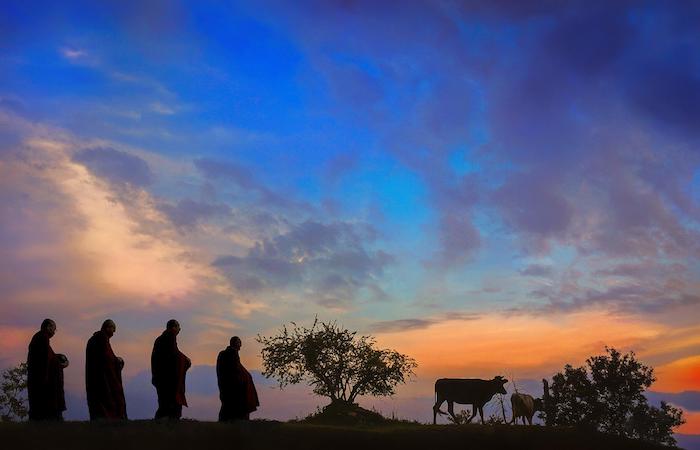
After his morning meal it was the Buddha’s habit to go to some quiet place nearby to either meditate or just sit quietly. If he decided to meditate, he would make a simple seat for himself from nearby vegetation or use a mat which he either carried or an attendant carried for him. After making himself comfortable, he would pull part of his robe over his head, possibly to keep insects off his face or to shelter his eyes from the light, and sit with his legs either crossed or folded (S.I,167; Sn.p.79-80). The lotus posture (padmāsana), in which the legs are interlocked, is now often associated with meditation and haṭha yoga but is not mentioned in the Tipitaka. He also said that he would keep his body straight, which means he kept his back upright, although probably without being rigid or forced. When he had finished meditation, he would spend some time walking up and down, no doubt to ease the stiffness in his legs and to get the blood in them moving (D.II,80).
There are numerous references to the Buddha meditating but surprisingly few about what kind of meditation he did. One of these says that during a three-month solitary retreat he spent much of his time doing what was called mindfulness of breathing, which involves being aware of the in and out movement of the breath. However, a meditative state he described in detail, taught to his disciples, and very likely often spent time in himself, was called jhāna. The Tipitaka contains little information concerning how long the Buddha would meditate for, but once, he mentioned that he would sit completely still and without uttering a word for seven days and nights. During such meditation sessions, he would experience an intense happiness (M.I,93).
At some time in the day, probably in the morning, the Buddha would have attended to his personal hygiene, although the Tipitaka provides only scant information concerning this. There is no record of him cleaning his teeth, but, given that he commented on the benefits of doing so, it is certain that he did. He said: “There are these five benefits of using a tooth stick. It is good for the eyes, the breath does not smell, the taste buds are cleansed, bile and phlegm do not mix with the food, and one’s food is appreciated” (A.III,250). In one extraordinary passage, surely unique in religious literature, he said that when he was travelling and needed to defecate or urinate, he would look up and down the road to make sure no one was coming before relieving himself (A.IV,344). There is a brief description of the Buddha standing in a bathing robe drying himself after having bathed in the Aciravatī River near Sāvatthī (M.I,161). This is said to have taken place in the early evening. There is another reference to him bathing, again in a river and again later in the day. When he and the group of monks who accompanied him arrived at Daṇḍakappaka after a long walk, he sat at the foot of a tree while they went into the town to see if the public hall was available for them to stay in. On their return, they all went together to the nearby river to bathe and wash off the dust and sweat of the day’s traveling (A.III,402). In the day before his final passing while in Pāvā, he suffered an attack of diarrhoea and later bathed in Kakuṭṭhā River, perhaps he had become soiled and needed to clean himself (D.II,134).
At around midday the Buddha would take an afternoon nap or siesta (divāseyyā), although he probably only did this later in life and only during the height of the summer. The ascetic Saccaka once asked him if he slept in the afternoon, and he replied: “I acknowledge that in the last month of the hot season, after returning from alms gathering and having eaten my meal, I would fold my robe into four, spread it out, lie down and go to sleep mindfully and fully aware”. Saccaka was not impressed by this and sniffed: “Some would call that abiding in delusion” (M.I,249). During such naps the Buddha would lie down in what he called the lion posture: reclining on his right side, with one foot on the other.
In the second half of the day the Buddha had no set program but might be involved in a range of activities: instructing his monks and nuns; talking with the various people who came to see him; continuing his journey if he was on a walking tour; or just sitting quietly by himself.
While the Buddha was happy to make himself available to anyone who wanted to talk with him, there were times when the crowds and the inquirers became irksome. Even while walking through the streets alms gathering or standing at a door to receive something, he would occasionally be approached by someone wanting to talk to him or ask him a question. When this occurred he would put the person off by saying that it was not the right time, although if the person persisted, and some did, he would speak with them, if only briefly (S.II,19; Ud.7-8). When the villagers of Icchānaṅgala came to know that he and his monks had arrived in a nearby forest grove, they streamed out to see him, bringing offerings of food. In their enthusiasm they made a great noise, causing the Buddha to complain that they sounded like a group of fishermen hauling in nets full of fish (A.III,30-31). A similar thing happened when the Buddha was staying in one of his favourite haunts on the edge of the Mahāvana north of Vesālī. A large crowd of Licchavi worthies, chariots and all, streamed out of the city to see him, chatting, laughing and making a great racket. When the monks who were with the Buddha heard the noise and realized what was soon to happen, they quickly made themselves scarce, leaving the Buddha to deal with the crowd (A.V,133).
There were those who expected the Buddha to be on call for them no matter what he was doing at the time. Once, a group of people, including some eminent brahmins visiting from Magadha and Kosala, went to where the Buddha was staying and asked his attendant, Nāgita, where he was and if they could have an audience with him. Nāgita had been instructed by the Buddha that he was not to be disturbed, so he replied: “Now is not a good time to see the Lord, as he has retired”. Unused to having their requests ignored and determined to see the Buddha, the brahmins sat down, asserting that they would not leave until they had seen the famous teacher. Shortly afterwards the novice Sīha turned up, saw all the people waiting, and pointing this out to Nāgita, suggested that he inform the Buddha that there were people who wanted to see him. Nāgita replied that he would not do this but would not object if Sīha did. Sīha went into the residence and informed the Buddha that there was a crowd outside wanting to see him, and he, giving in to the inevitable, said to Sīha: “Prepare a seat for me in the shade of the building”; he then came out, took a seat and conversed with the brahmins (D.I,150-52). On rare occasions, if the Buddha decided that a visitor had no real interest in Dhamma and just wanted to chat, or if his meditation had left him utterly serene and he just did not wish to talk, he would engage the visitor briefly and then bring the conversation to a close so they would leave (M.III,111).
Given all this, it is hardly surprising that the Buddha sometimes felt the need to refresh himself with periods of solitude and silence. Occasionally he would have what he called a day’s abiding (divāvihāra), as when he asked Ānanda to bring a sitting mat and follow him to Vesālī’s Cāpāla Shrine so he could spend the day there without being bothered (M.I,229; S.V,259). Another example of this is when he decided to spend the day in the forest completely alone, instructing Ānanda, who was usually always by his side, not to follow him (A.IV,438). There were times when he went for extended retreats, announcing: “I wish to spend the next half month in solitude. No one should come to me except the person who brings my food” (S.V,12; V,320). When the Buddha undertook extended retreats he would do so in any nearby stretch of forest. Some monastics appreciated forests not just for the quiet and solitude they afforded but also for their sylvan beauty. Sāriputta mentioned how beautiful the Gosinga forest was in the moonlight when all the sal trees were in blossom and their scent wafted through the air (M.I,212). The Buddha too was sensitive to the beauty of the forest environment. When someone asked the him if he was afraid to stay alone in the forest he replied: “At the midday hour when the birds are quiet, I find the rustle of the great forest delightful” (S.I,7).
The Buddha had once said that his monastic disciples should look upon him as a father and that he in turn would treat them as his offspring; monks and nuns called themselves and were known to others as “sons of the Sakyan” or “daughters of the Sakyan”. The Buddha demonstrated this paternal affection towards all his disciples, monastic and lay, by his concern for their spiritual welfare and also for their physical well-being. When he met Soṇa, who had come all the way from Avanti to Sāvatthī to see him, he asked Soṇa if he was alright. “I hope you are managing, I hope you are in good health, I hope you are not too fatigued by your journey, I hope you had few problems getting food?” Soṇa replied that all was well with him, and then the Buddha instructed Ānanda to arrange suitable accommodation for the newcomer (Ud.59). When someone’s health broke down he would find the time to visit them, whether they be a monk in one of the infirmaries attached to some monasteries or a lay person in their home (A.III,142; 379; S.IV,210; V,344-45). On such occasions he would inquire about the patient’s condition and encourage them with a talk on some aspect of the Dhamma. It became well known in the Saṅgha that: “Ministering to the sick is praised by the Lord” (bhagavatā kho āvuso gilānupaṭṭhānaṃ vaṇṇitaṃ, Vin.I,303).
The Buddha’s interactions with people would slow down after sunset, giving him more opportunity to rest and relax. The Tipitaka provides little information about when and for how long the Buddha would sleep at night. He asked his monks and nuns to remain awake, either meditating or mindfully walking up and down, during the first and last watches and sleep only during the second watch, a schedule that he presumably followed as well (A.I,114;Dhp.157). Night was considered to start at sunset and end at sunrise, and the intervening period was divided into three watches (yāma), the length of each differing according to the season. The Buddha is said to have sometimes spent much of the night walking up and down or giving a talk (S. I,107; D.II,86). Other texts simply say that he spent the night in the open rather than in a building or under shelter, and not just in the summer but even during the winter when nights could be very cold (Vin.I,196; S.I,107; Ud.59). When he was staying in a forest grove outside Āḷavī, he made a bed for himself out of leaves, which he would also sit on while meditating. He would not have plucked these leaves but collected fallen ones from the ground (A.I,136). Two texts describe him spending the night in the open despite a light shower of rain (S.I,104; Ud.4). The evidence suggests that the Buddha was in the habit of finishing his meditation and starting his day’s activities shortly before dawn.
Abbreviations
- Aṅguttara Nikāya; D. Dīgha Nikāya; Dhp. Dhammapada; M. Majjhima Nikāya; S. Saṃyutta Nikāya; Sn. Sutta Nipāta; Ud. Udāna; Vin. Vinaya Piṭaka.

